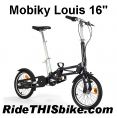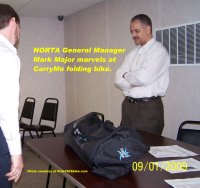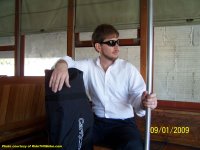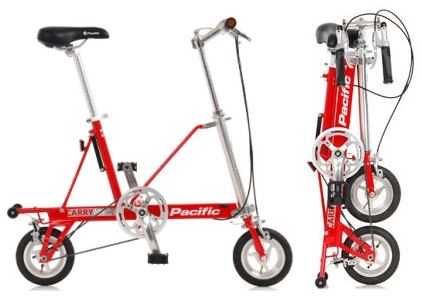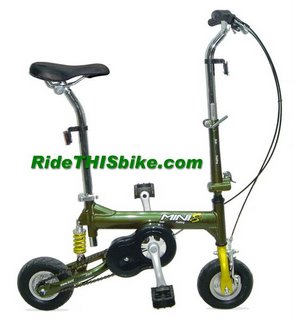by Larry Lagarde
I'm attending a transportation demand management symposium this week and was doing some research regarding how far people are willing to walk to get to a bus or light rail stop. A variety of studies have been done in North America; however, most found that the distance varied from a quarter mile to a half mile or roughly no more than 15 minutes on average.
If you'd like to see the data and references, read on.
North American Mass Transit Walking Distance Research Study Results/Statements:
(as collected & published by the Fairfax County Planning Commission Transit Oriented Development Committee for their TOD meeting of 9/7/2006)
http://www.fairfaxcounty.gov/planning/tod_docs/walking_distance_abstracts.pdf.
Calthorpe Associates: Project Sheets-TOD Guidelines
http://www.calthorpe.com/Project%20Sheets/TOD%20Guidelines.pdf
- Briefly defines TODs as mixed-use districts within a comfortable walking distance of transit - about 2,000 feet
Dittmar, H., and G. Ohland, eds.
The New Transit Town: Best Practices in Transit-Oriented Development.
2004. Island Press. Washington, D.C. p. 120.
"Locate development close to transit. Effective TOD places residential and office space as close to transit as possible. The optimal walking distance between a transit station or stop and a place of employment is 500 to 1,000 feet. Residents are willing to walk slightly longer distances to get to transit, between a quarter- and a half-mile."
Envisioning Neighborhoods with Transit-Oriented Development Potential
http://transweb.sjsu.edu/publications/envisioning/Envisioning.htm
- Defines walking distance (<1/2 mile), bicycling distance (<2 miles), and five-mile driving or transit distance. These ranges of analysis include the areas where residents of possible TODs might work, shop, or prefer to go for services. Case studies are from bay Area of San Francisco (Campbell light rail, Fruitvale BART in Oakland, Hayward BART, Mountain View CalTrain/light rail, Redwood City CalTrain, and the Sacramento 65th Street Station). Study uses these distances as a starting point, not as a point of research.
TOD Manual Walking Distance Recommendations from Other Jurisdictions/Transit Agencies
- Mass Transit Administration (Maryland): 1500 ft. (0.28 mi.)
- Mid-America Regional Council (Kansas City, Missouri): 1500 ft. (0.28 mi.)
- NJTransit (New Jersey): ¼ - ½ mi
- Ontario Ministry of Transportation: 400m (0.25 mi.)
- Regional Plan Association (NY, CT, NJ Tri-metro area: ¼ mi.
- Snohomish County Trans. Authority (Snohomish Cty, Washington): 1000 ft. (0.19 mi.)
Mass Transit Administration (1988) Access by Design: Transit’s Role in Land Development. Maryland Department of Transportation.
- Recommended spacing for bus stops is calculated based on a cachment area of 1500 feet (0.28 mi.) from each side of the road traveled, defined as the are from which most passengers can easily walk to access transit service. Passengers within this distance are considered to be "adequately served." Closer spacing is recommended for higher density areas (section 5.1.2).
Mid-America Regional Council (No Date) Transit-Supportive Development Guidebook. (Kansas City, Missouri). http://www.marc.org/transportation/TSD%20Guidebook.pdf
- Indicates most people are willing to walk 1500 feet (0.28 mi.) to shopping or transit (Chapter 4, Pedestrian Scale Blocks, p. 48), and suggests that short, walkable blocks increase the attractiveness of pedestrian transit. NJTransit (1994) Planning for Transit-Friendly Land Use A Handbook for New Jersey Communities. Defines reasonable walking distance by general understanding of willingness to walk 5-15 minutes to get to or from a transit stop, corresponding to ¼ to ½ mile, but varies based on topography, sense of safety and security, presence of interesting activity (Section 1.3).
Ontario Ministry of Transportation (1992) Transit-Supportive Land Use Planning Guidelines. Ontario Ministry of Municipal Affairs.
http://www.mah.gov.on.ca/userfiles/page_attachments/business/transuppguid/transuppguid-e.pdf
- Transit-oriented design guidelines developed by the Ontario Ministry of Transportation reference 400m (1/4 mile) walking distance throughout this document as a basis for recommendations.
Regional Plan Association (1997) Building Transit-Friendly Communities A Design and Development Strategy for the Tri-State Metropolitan Region. (New York, New Jersey, Connecticut).
- Defines transit-friendly communities as intensively developed areas within ¼ - ½ mile of rail stations. A distance that can be comfortably walked in 5-10 minutes and a distance most people are willing to walk to train stations or other community uses. These areas include mixed uses, pedestrian connections, and traffic calming design. Cites a study showing that residents living within ¼ mi. of rail stations are five-to-seven times more likely to use rail than other area residents (Relationship Between Transit and Urban Form Handbook, Transit Cooperative Research Program TCRP H-1, November 1995, page 29.)
Snohomish County Transportation Authority (1989) A Guide to Land Use and Public Transportation for Snohomish County, Washington. (Snohomish County, Washington).
http://ntl.bts.gov/DOCS/GL.html
- "People can be expected to walk no more than 1,000 feet to a bus stop or a park- and-ride parking space. The walking distance increases slightly, to 1,320-1,758 feet (1/4 to 1/3 of a mile), for rail station access." (Chapter 3).
Quantitative Studies:
Best Development Practices: A Primer.
Ewing, R. (1999) EPA Smart Growth Network, pp. 1-29.
http://www.epa.gov/dced/pdf/BestDevprimer.pdf
- See p. 8. Suggest destinations to which we expect people to walk should be no further than ¼ mile distance. (References data from: Tabulations from the 1990 Nationwide Personal Transportation Survey (NPTS).)
Pedestrian and Transit Friendly Design: A Primer for Smart Growth.
Ewing, R. (2000) EPA Smart Growth Network, pp. 1-22.
http://www.epa.gov/dced/pdf/ptfd_primer.pdf
- Also cites the same 1990 NPTS Study (see page 5). These documents both present brief summary of quantitative analysis not discussed in these publications.
References:
P.N. Seneviratne, "Acceptable Walking Distances in Central Areas," Journal of Transportation Engineering, Vol. 3, 1985, pp. 365-376
(Abstract can be found at: http://www.pubs.asce.org/WWWdisplay.cgi?8501920 . For registered subscribers of The Journal of Transportation Engineering, full text is available at:
http://scitation.aip.org/getabs/servlet/GetabsServlet?prog=normal&id=JTPEDI00=0129000006000684000001&idtype=cvips&gifs=yes )
From footnote: "Travel distances were estimated assuming everyone walked at the National Personal Transportation Survey average speed of 3.16 mph. Curves were smoothed to account for people’s tendency to round off travel times."
Bureau of Transportation Statistics:
http://www.bts.gov/programs/national_household_travel_survey/
National Household Travel Survey:
http://nhts.ornl.gov/2001/index.shtml
TCRP Report 102: "Transit-Oriented Development in the United States: Experiences, Challenges and Prospects" Transportation Research Board, 2004.
http://onlinepubs.trb.org/onlinepubs/tcrp/tcrp_rpt_102.pdf
Cites 1987 WMATA study by JHK and Associates (Development-Related Survey I)
*See attached Table 8.1 "Modal Splits for Residential Projects Near Metrorail Stations, Washington (D.C.) Metropolitan Area, 1987.
Relationship Between Transit and Urban Form Handbook, Transit Cooperative Research Program TCRP H-1, November 1995, page 29
Digest version: http://onlinepubs.trb.org/onlinepubs/tcrp/tcrp_rrd_07.pdf
- Study of ridership among housing and commercial developments near 4 rail stations in Canada found a "walking impact zone" as far as 4,000 feet (3/4 mile) from a station, a "distance that can accommodate around 1,200 acres of development, sufficient to create strong transit-oriented communities."
- Study by JHK and Associates in 1986, 1989 showed that the "share of trips by rail or bus transit declined by around .65 percent for every 100-foot increase in distance of a residential site from a Metrorail station portal."
- Cervero et. al 1993 - In the Bay Area, 92 percent of those living within ¼ mile of a BART station and commuting to San Francisco where parking costs were over $2 per day commute via rail transit.
Rail Transit Impact Studies: Atlanta, Washington, San Diego.
Paget, Donnelly, Price, Williams and Associates. March 1982. p. 28.
- In the Washington metropolitan area, it was found that the average walk to/from a Metrorail station ranged between ¼ to 1/3 mile. Walking time/distance ratios appear to coincide with actual land use development in the stations vicinity—station area development had occurred primarily within ¼ mile of the station.
BART’s First Five Years; Transportation and Travel Impacts
(April 1979) DOT-P-30-79-8.
- (This study surveyed mode of access which was then converted to distance) In the San Francisco Bay Area Rapid Transit System (BART), 80% of the pedestrians using BART during peak hour periods walked less than 10 minutes to the station, while somewhat over half of those pedestrians walking under 6 minutes to reach their destination. The distance for a 6 minute walk was estimated to be a quarter of a mile.
1976 survey data included in Appendix:
- 30% of trips walked to BART station
- Of that 30% who walked, 80% walked less than 10 minutes (45% walked under 6 minutes (approximately 1350 feet) and 35% walked between 6-10 minutes, approximately 1350 to 2250 feet)
- Distance for a 6 minute walk was estimated to be about ¼ mile
- Overall average walking time for all who walked to the BART stations was 8.8 minutes
- Generally considered that the average person walks about 225 feet per minute
- Overall average length of walk was probably about 1,980 feet (.375 miles)
- Average walking time for walkers to their destination at end of trip was 7.2 minutes or about 1,600 feet (1/3 mile)
Northern Virginia Metro Station Impact Study: Development Potentials at Metro Stations.
Gladstone Associates. June 1974, p. 23.
- Gladstone study identified a primary area of development potential within 1000 feet (.19 miles) of a Metrorail entrance and a secondary area within one half mile of the station site. Planned station areas in Alexandria and Arlington County generally reflect this concept. Alexandria’s King Street Station study area is within a 5 minute walk (approx. 1300 feet, .25 miles) of the station with the remaining area within a 10 minute, one half mile walk. Arlington’s Ballston and Courthouse planning areas encompass acreage generally within .4 and .3 miles, respectively, of the station.)
- Montgomery County’s Takoma Park station had a primary transit impact area within 1000 foot radius of the station with the secondary area of impact encompassing acreage within a half mile radius. The transit impact area for the Forest Glen, Glenmont and White Flint stations was identified as acreage within a 2000 foot radius from the station. Note that natural or man-made barriers such as floodplains, railroads and highways affected that actual area studied (for example King Street’s adjacent railroad right-of-way formed the western boundary to the study area even though a portion of the acreage on the opposite side was within ¼ mile of the station.
Gruen, Victor, The Heart of Our Cities. The Urban Crisis: Diagnosis and Cure.
Simon and Schuster 1964, New York, p. 250: (used in Fairfax County Metro Station Areas Study, 1982)
Chart to illustrate people’s tolerance for walking in various environments:
- 20 min or 5000' in a highly attractive, completely weather- protected and artificially climatized environment
- 10 min or 2500' in a highly attractive environment in which sidewalks are protected from sunshine and rain
- 5 min or 1250' in an attractive but not weather-protected area during periods of inclement weather
- 2 min or 600' iIn an unattractive environment (parking lot, garage, traffic-congested streets)
Planning for Man and Motor
Ritter, Paul, Pergamon Press, New York, 1964, p. 14
- "An average walk is at a speed of 2.5 miles per hour. This converts to 13,200 feet per hour or 220 feet per minute. On this basis, a 5-minute walk would be 1,100 feet and a 10-minute walk would be 2,200 feet."
Public Transportation and Land Use Policy
Pushkarev and Zupan. Indiana University Press from a study by Regional Plan Association of New York (RPA).
- "In Montreal, in order to maximize pedestrian access to stations, the stations were planned 0.6 miles apart assuming maximum reasonable
walking distance of .3 miles.
- Tri-State Regional Planning Commission’s 1963 Home Interview Survey indicates that, outside downtown areas, people reported their walk to a bus to be, on the average, in the 3-4 minute range, their walk to a subway or rail station to be in the 5-10 minute range, and their drive to rail stops to average 7-15 minutes.
- The pedestrian access trip to stations responds to station spacing only in a very limited manner. The median walk to subway stations does increase from 0.17 miles in midtown Manhattan, where stations are very closely spaced, to about 0.32 miles at the edge of the subway-served territory.
- It appears that no matter how station-spacing increases, 50 percent of the people will not walk more than 6 minutes or 0.3 miles to a non- downtown rail station, even if there is a fraction of 1 percent who will walk over 30 minutes or more than 1.5 miles. This is not inconsistent with the finding that a distance of 2,500 feet or a 9-minute walking time (assuming, all the while, an average walking speed of 3.1 miles per hour), 50 percent or more of those traveling that distance will prefer a feeder bus to walking, even in a low-income area, with a double fare."
WMATA 2005 Development Related Ridership Survey Final Report, March 2006
(Update to 1989 survey to determine if changes in population growth, the regional economy, and the built environment had affected modal splits at certain types of land uses in Metrorail station areas, and if certain physical attributes of these land uses impact transit ridership.)
- "2005 survey results confirmed previous findings that the walking distance between a site and the Metrorail station affects transit ridership. In general, the closer a site is to the station, the greater the likelihood those traveling to/from a site choose Metrorail as their travel mode. Based on the survey results, this relationship was stronger for residential sites than for office sites."
*See attached Table S-2, Figure 14 and Figure 15 O’Sullivan, Sean and John Morrall. Walking Distances to and from Light-Rail Transit Stations. Transportation Research Record 1538.
http://scholar.google.com/scholar?hl=en&lr=&q=cache:oEPEiEPfnFAJ:www.enhancements.org/trb%255C1538-003.pdf+O%27Sullivan+S.+and+Morrall,+J
Abstract:
"…For the city of Calgary the average walking distance to suburban stations is 649 m with a 75th-percentile distance of 840 m. At CBD stations the average walking distance is 326 m and the 75th-percentile distance is 419 m."
Average walking distance to suburban station=649m=2129 feet=0.4 miles
- 75th percentile (suburban stations): 840m=0.52 miles
In CBD, average walking distance = 326m=0.2 miles
- 75th percentile (CBD): 419m=0.26 miles
- Calgary, Canada: pedestrians are more than 25% of peak-period trips to or from suburban stations
- General walking distance is about 5 minutes or 400m (.25 miles)
- Analysis in San Francisco and Edmonton, Canada found that 1750m (1.08 mi) was maximum that people would walk to a station, and that walking accounts for more than 50% of the access mode from distances up to approximately 900m (0.56 mi).
Survey of walking distance guidelines used by North American companies
- Canada: guidelines range from 300m to 900m (0.18 mi to 0.56 mi)
- U.S.: generally between 400m and 800m (0.25 mi to 0.50 mi)
Labels: mass-transit
